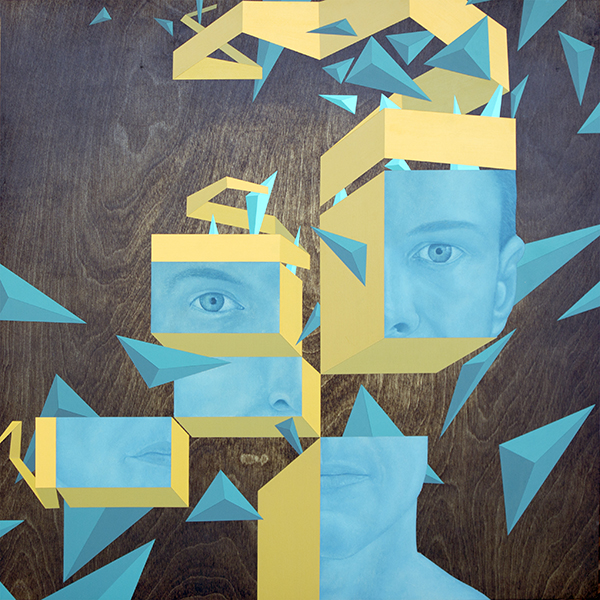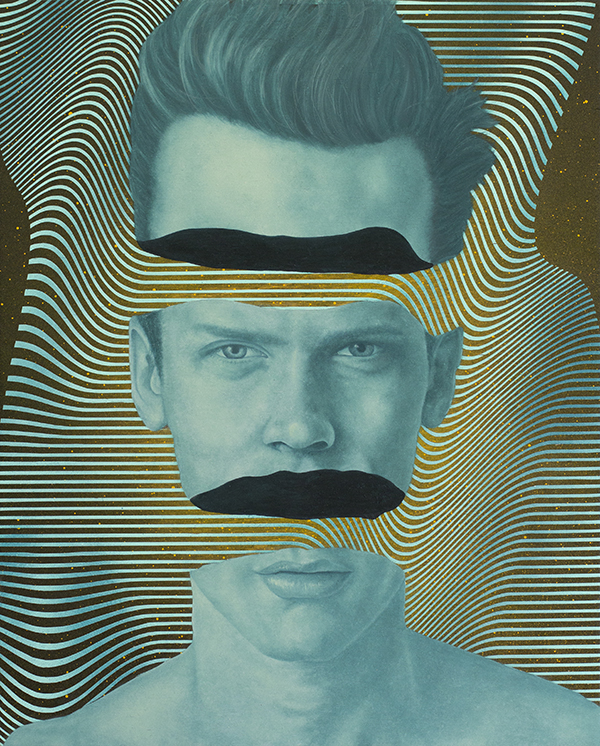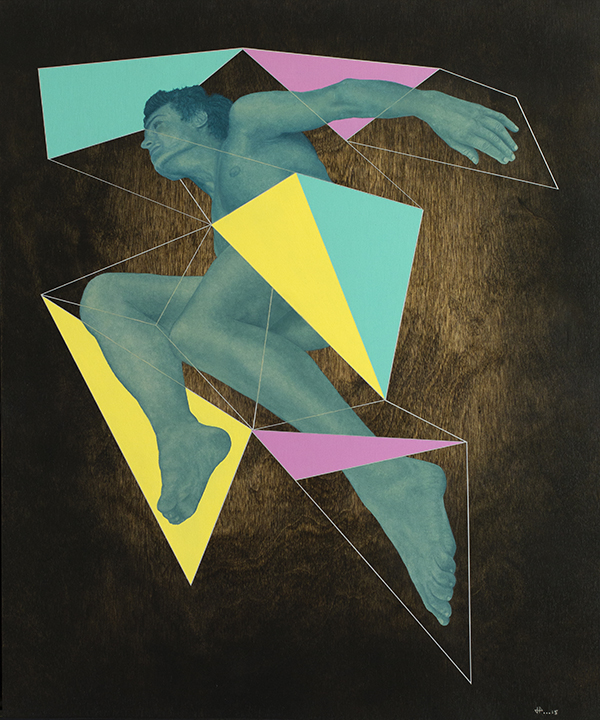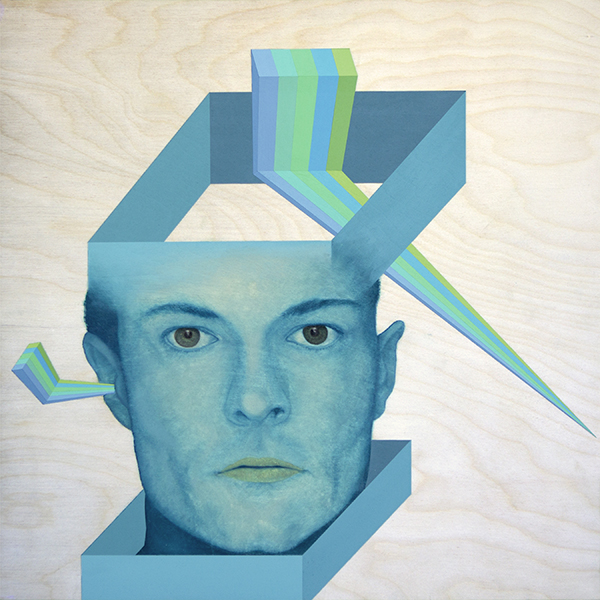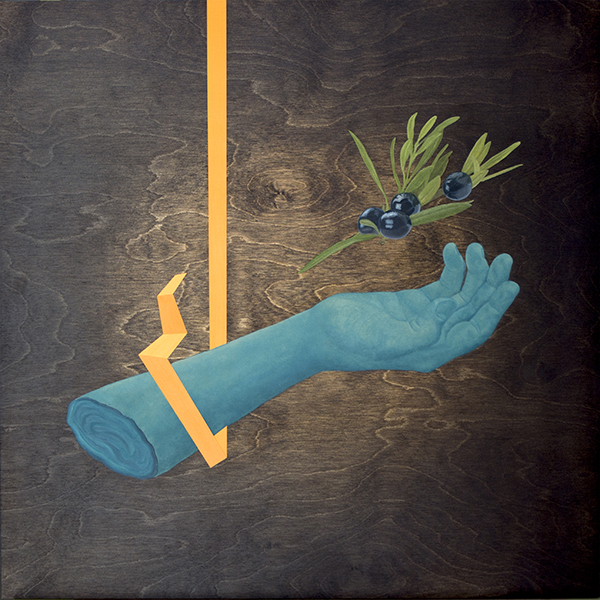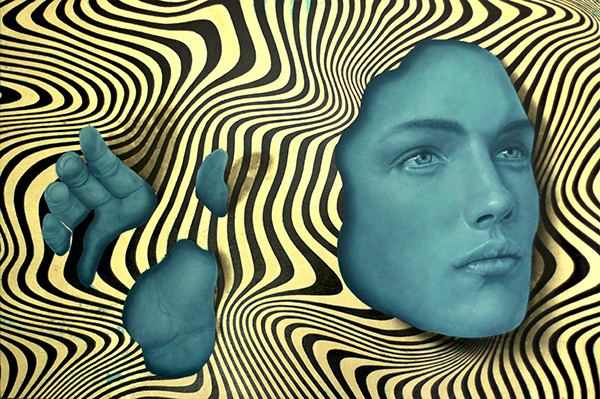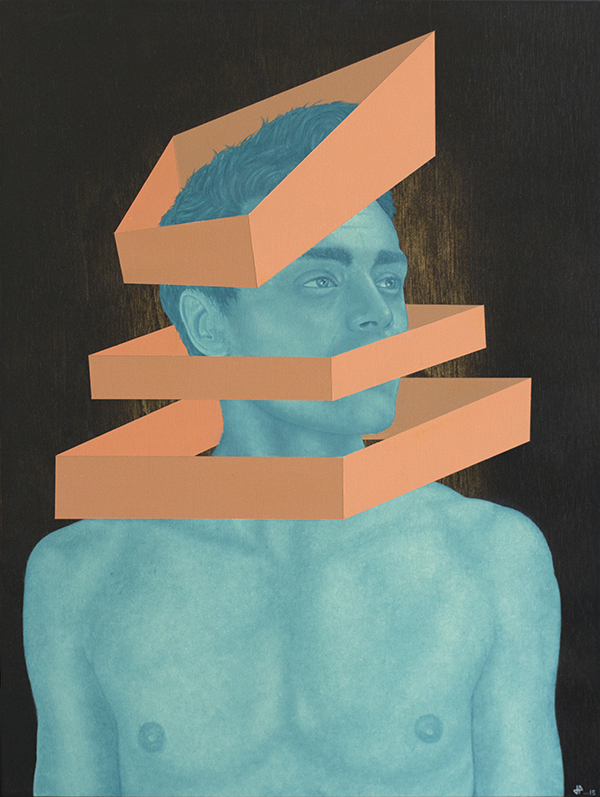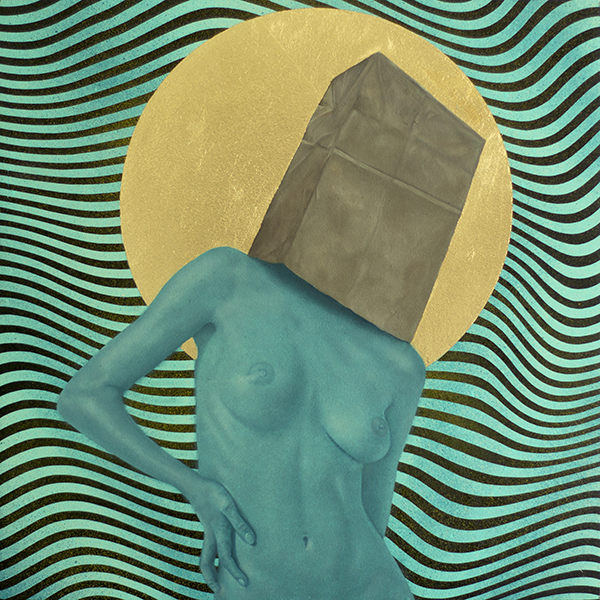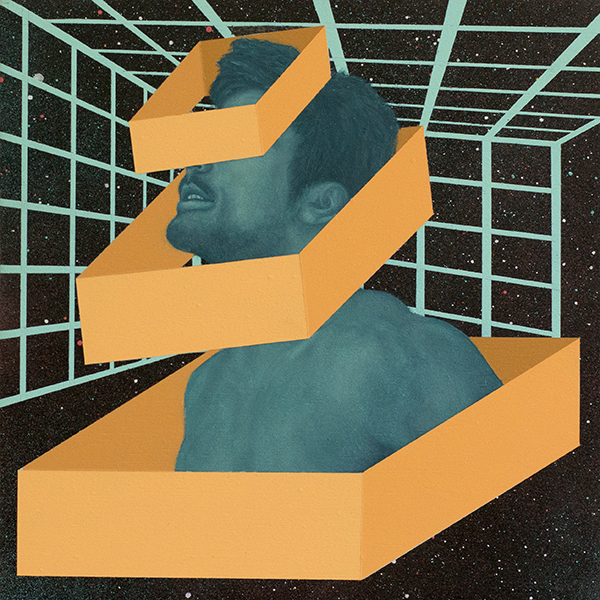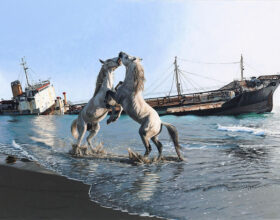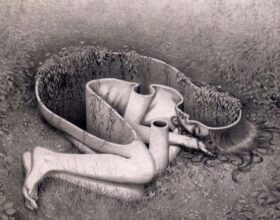In a world where information and communication go hand in hand, figurative painting still distinguishes itself as the oldest yet most captivating means to talk about psychologically-charged subjects pertaining to the interactions between visual stimuli and perception. Although today’s gallery and museum visitors are used to unpredictable creative stratagems and technological devices – interactive sculptures imitating human forms and movements, naked body painted models spitting fire from their ears and mouths, and shape-shifting alien robots vomiting inter-dimensional black holes, painting still remains artists’ most common and accepted way of expressing visual opinions and feelings.
In this light, Johnie Thornton is a kind of contemporary hero incorporating – and fighting – innovation while evoking nature’s palette and launching viewers into a garden of delights inhabited by timid nymphs and adventurous kings, all destined to meet at the intersection of odd green skins and eye-squinting golden stripes. In Thornton’s painted world, the rich surfaces of his canvases are precious beds of invisible jewels covered in thin diamond dust.
Johnie Thornton’s exhibition “Transitory Profusion” is currently on view at Woodman/Shimko Gallery (April 2 – April 30, 2016).
Where did your fascination for figurative art come from?
It really started when I was a child. My uncle Bruce was a painter before becoming a successful lawyer, and he had his work on display all throughout his house. My uncle’s work was very Daliesque, and filled with figures, abstractions, architecture, geometries and nudes. I was fascinated by these illustrations and paintings and would spend hours staring at them. In my early teens, I discovered artists like Mark Ryden and Robert Williams, and was completely blown away by their abilities.
It started out on a strictly visual level for me but as I dug deeper into their work, I noticed so much more was there… for instance, the ability to express feelings, emotions, and opinions in art, political and religious metaphors. I, too, was looking for a way to express feelings of fear, self-loathing, anger and hatred. Feelings that were almost drowning me alive. I saw no hope in the world around me until I dug deeper into art. Growing up as a gay kid in a right wing religious environment definitely left me feeling very alone and hopeless, so the only healthy way I had to cope was making art, and figurative art really struck that nerve for me.
Then, at some point, you decided to mix figurative and abstract art in your compositions. Are you following some contemporary trend and responding to the demands of today’s art collectors, or is there something else happening?
I’d like to think the contemporary art world doesn’t affect me, and I stay away from trends in art, or from trends in general. I have always been a bit of an outsider, never too close to the flock. I make art for myself. However, I’m glad collectors and galleries have been paying attention to my work – they have afforded me the opportunity to work as a full-time artist.
When I first started painting, I tried to make work as complex and wonderful as the paintings that influenced my sensibility growing up. Back then, I really had no idea how to paint at all, I just knew what I wanted to say. I dabbled in painting for several years, never really putting enough thought into it. Then I began making stencils and I loved the fast clean images I achieved, so I started there. Stencils lead to a fascination with geometric figures and graffiti; I began leaning more towards geometric figures and abstractions, and my work became very hard-edged and colorful. A year and a half ago I decided to teach myself how to paint figuratively, and to paint in oils. I tried in the past to express my ideas in a figurative mode, but was never terribly happy with the results. I studied other artists’ paintings for years and was determined to figure out or better, invent, my own methods, in order to achieve the aesthetics I desired. I am still learning with each painting, and am making great strides in my abilities as a painter in the process. I look forward to what the future holds in store for me.
Do you remember any of the great masters of the past who were already mixing up figurative and geometric shapes?
I think a lot of my interest in architecture and geometry came from studying works of old masters. I found it fascinating that these painters were able to get the amount of precision and detail in their works with a completely archaic set of tools. When I looked at the Surrealists, it blew my mind. I was living in the age of computers and television, and these artists had come up with such fantastic images and ideas well before modern tools of design existed. It was only in my studies where I came to find that math and geometry enabled these artists to accomplish such things. This idea really sparked my interest in geometry, as I saw it as a tool I needed to master. After several years painting using geometrics to figure out compositions and really just learning some of the basics of the craft, I feel that I’ve come full circle and now I’m able to master these tools – use them in my new work to create something forward thinking and fresh.
Which came first, in your opinion, abstract or figurative art?
That is a tricky question. According to most art historical sources, figurative art came first; abstraction followed in a pronounced way in the early 1900’s. But it was the result of previous figurative painters evolving into what would eventually become a full on movement. There has been figurative work around since the time of cavemen, whether you would call that art or not is up to you, I guess, but there are also findings suggesting 70,000 year old abstract art as well. Personally, I think abstraction has always existed; it had simply never been defined as “art” by some institution up until a certain point.
I see abstract art all around me on a daily basis, from a stain on the cement to light reflected on the water. I would have to think this has been going on since before man could even express or comprehend the idea of art. I think that as humans we need things to be defined and solidified, and placed into neat little cubbyholes, so there is a constant structure in how we absorb and rewrite the world around us. I don’t think art fits into these constraints, though society has tried to make it so throughout history. Art is something bigger than what can be defined and categorized. So I guess my answer would be, in my opinion, abstract art is older to date on a technicality.
How do you chose your models and what do you do once you feel you’ve been able to find the right subjects for your compositions?
I feel that my models have chosen me, in a way. When I have a painting in mind a lot of importance is placed in my model’s’ ability to embody what I’m trying to portray. I usually search until I “just know” I’ve found the right face, or body, or whatever it may be. I reach out to models or people who aren’t professional models, even, and ask if I can paint them.
Why do you appear to have a peculiar connection with (or fixation for) green and gold?
The fixation for green or teal is simply a personal preference. If you look at my early work you will see this color in almost every painting. I have stuck with painting my human figures in these tones because I really like representing something in a photorealistic manner, but staying within a monochromatic palette. There is a certain disconnection that takes place when we’re presented with a visual depiction of a person or object outside of the conventional representation of that person or object. I like that the viewer can relate to the human form in my work, yet the form still remains unfamiliar and detached in a sense. I think it has also helped my work stand out from other realist and figurative painters. Whereas the gold in my most recent work is much more deliberate. Gold itself was a big part of a fluid theme in my most recent works, and was therefore a necessary visual representation.
Are viewers supposed to see something particular in your works?
Yes – whatever it is that they are supposed to see. But people will see or process things in relation to their own experience and understanding. A majority of my work is intentionally visually elusive to the viewer upon first glance, as it is meant to be a catalyst for thought, and upon further dissection, it will hopefully become rather clear.
The themes in my paintings have been focused on the human condition from many different facets, and have stemmed from a personal existential pursuit. I am mostly approaching ideas I would otherwise be unable to fathom, and trying to make sense of them myself, it just so happens that I now have some passengers, or viewers, along for the ride. I definitely hope that along the way I am able to have a positive impact on my audience. I tend to stay away from art that is spoon fed to me, whether it is music, visual art, writing, or any other form of art/content. I like a challenge, and I like to be challenged by the things I choose to consume, therefore I hope to attract a like-minded audience, with my work.
Do you think art might have a higher purpose than our obsessive attempt to constantly celebrate beauty, symmetry, and perfection?
Most definitely. I think that social media and the internet has had a big part to do with this obsession, as content is in such high demand and needs to be eye-catching in order to garner clicks! With my work, I try to ride the line between the gorgeous and the grotesque. Most of the time the ideas expressed in my work is the grotesque center of the gorgeous outer shell that is the painting. I use this to strengthen my metaphors.
I’d say you are particularly ambitious. Are you aiming at something beyond an international audience, fame and fortune?
Ambition is what has gotten me to this point in my journey. I never thought that trying to make a career out of being an artist would be easy, but I also had no idea what I was getting myself into! It’s pretty much impossible to make it as an artist unless you have a drive like no other or unless you have a trust fund! I don’t have a trust fund, and I don’t care about money really, so sales to me just mean I can keep painting. My ultimate goal in life is to help people. As a child, I wanted to be a doctor, and then I grew up and saw that the American medical industry is more about making profit and less about helping people. When I started on my path as an artist, I was completely lost and confused, but as I grew into my career, I slowly found what I would like to make of my future. My aim now is to continue on this trajectory, and as I gain success and resources, I hope to begin setting up a platform to help other artists.



